Study on the Strength and Microcosmic Characteristics of C50 High-Performance Concrete (HPC) Containing Manufactured Sands
Abstract
:1. Introduction
2. Specimen Design
2.1. Materials
2.2. Mix-Design
2.3. Concrete Mixture and Specimen Preparation
3. Testing Methods of Expansion, Compressive Strength and Microscopic Character
3.1. Fluidity Tests
3.2. Compressive Strength Test
3.3. Microscopic Character Test
4. Results and Discussion of the Fresh Concrete and Compressive Strength
4.1. Fresh Concrete Workability
4.2. Compressive Strength
5. Results and Discussion of the Concrete Microstructure
5.1. Microstructure of the HPC
5.1.1. MIP Test
5.1.2. SEM Test
5.1.3. EDS Tests
5.2. Mechanism Discussion
6. Conclusions
- (1)
- C50 HPC with coarse aggregate has many advantages over conventional concrete; for example, all aggregates are locally sourced and belong to waste utilization, low production and transportation costs, and preservation of natural resources.
- (2)
- The larger specific surface area of the superfine mixing powder and high water demand affect the workability of the fresh C50 HPC. In addition, aggregate particles that are too coarse or too fine may decrease the HPC workability.
- (3)
- The type of aggregate significantly impacts the compressive strength of C50 HPC. The medium gradation aggregate and mixture containing FA, SH, and RM help improve the HPC compressive strength.
- (4)
- The excellent and low porosity performance of manufactured sand C50 HPC is mainly attributed to the rational design of the mixture with cementitious systems containing silicate cement clinker, FA, SF, and RM. The superfilling effect, pozzolanic reaction, and microaggregate effect of the composite admixtures result in highly developed hydration products, produce a synergistic effect, and form a dense stereoscopic honeycomb structure with low porosity and strong ITZ bonding between matrix and aggregate.
- (5)
- Compound admixture of C50 HPC with FA, SF, and RM had a good fluidity and the highest compressive strength. It can be seen from the microscopic analysis that the concrete with MS-M grading was rich in hydration products, forming a honeycomb network structure, and the pore structure was mainly distributed in the range of less harmful holes. At this time, the comprehensive performance of concrete was the best.
Author Contributions
Funding
Institutional Review Board Statement
Informed Consent Statement
Data Availability Statement
Acknowledgments
Conflicts of Interest
References
- Zhang, P.; Hu, J.; Zhao, K.X.; Chen, H.; Zhao, S.D.; Li, W.W. Dynamics and decoupling analysis of carbon emissions from construction industry in China. Buildings 2022, 12, 257. [Google Scholar] [CrossRef]
- Makul, N.; Fediuk, R.; Amran, M.; Zeyad, A.M.; de Azevedo, A.R.G.; Klyuev, S.; Vatin, N.; Karelina, M. Capacity to develop recycled aggregate concrete in South East Asia. Buildings 2021, 11, 234. [Google Scholar] [CrossRef]
- Gradinaru, C.M.; Barbuta, M.; Ciocan, V.; Serbanoiu, A.A. (Eds.) A study on the effects of the cement and mineral aggregates replacement with waste materials. In Proceedings of the 3rd China-Romania Science and Technology Seminar (CRSTS), Brasov, Romania, 24–27 April 2018; Iop Publishing Ltd.: Bristol, UK, 2018. [Google Scholar]
- Silva, I.; Castro-Gomes, J.; Albuquerque, A. Mineral waste geopolymeric artificial aggregates as alternative materials for wastewater-treatment processes: Study of structural stability and pH variation in water. J. Mater. Civ. Eng. 2012, 24, 623–628. [Google Scholar] [CrossRef]
- Li, L.J.; Mai, G.H.; He, S.H.; Xiong, Z.; Wei, W.; Luo, H.W.; Liu, F. Experimental study on bond behaviour between recycled aggregate concrete and basalt fibre-reinforced polymer bars under different strain rates. Constr. Build. Mater. 2021, 290, 123218. [Google Scholar] [CrossRef]
- Chu, S.H.; Poon, C.S.; Lam, C.S.; Li, L. Effect of natural and recycled aggregate packing on properties of concrete blocks. Constr. Build. Mater. 2021, 278, 122247. [Google Scholar] [CrossRef]
- Arulmoly, B.; Konthesingha, C.; Nanayakkara, A. Performance evaluation of cement mortar produced with manufactured sand and offshore sand as alternatives for river sand. Constr. Build. Mater. 2021, 297, 123784. [Google Scholar] [CrossRef]
- Guan, M.S.; Liu, W.T.; Lai, M.H.; Du, H.B.; Cui, J.; Gan, Y.Y. Seismic behaviour of innovative composite walls with high-strength manufactured sand concrete. Eng. Struct. 2019, 195, 182–199. [Google Scholar] [CrossRef]
- Shen, W.G.; Liu, Y.; Cao, L.H.; Huo, X.J.; Yang, Z.G.; Zhou, C.C.; He, P.; Lu, Z. Mixing design and microstructure of ultra high strength concrete with manufactured sand. Constr. Build. Mater. 2017, 143, 312–321. [Google Scholar] [CrossRef]
- Vijaya, B.; Selvan, S.S.; Vasanthi, P. (Eds.) Experimental investigation on the behaviour of reinforced concrete column containing manufactured sand under axial compression. In Proceedings of the 3rd International Conference on Advanced Materials and Modern Manufacturing (ICAMMM), Tamil Nadu, India, 3–4 April 2020. [Google Scholar]
- Zhang, H.; Bai, L.Y.; Qi, Y.Z.; Hong, H.; Neupane, A.; Pan, Q. Impact of splitting tensile properties and dynamic constitutive model of fly ash concrete. J. Mater. Civ. Eng. 2020, 32, 04020225. [Google Scholar] [CrossRef]
- Guo, Y.Y.; Zhang, Y.X.; Soe, K.; Hutchison, W.D.; Timmers, H.; Poblete, M.R. Effect of fly ash on mechanical properties of magnesium oxychloride cement under water attack. Struct. Concr. 2020, 21, 1181–1199. [Google Scholar] [CrossRef]
- Sothornchaiwit, K.; Dokduea, W.; Tangchirapat, W.; Keawsawasvong, S.; Thongchom, C.; Jaturapitakkul, C. Influences of silica fume on compressive strength and chemical resistances of high calcium fly ash-based alkali-activated mortar. Sustainability 2022, 14, 2652. [Google Scholar] [CrossRef]
- Kapeluszna, E.; Kotwica, L.; Nocun-Wczelik, W. Comparison of the effect of ground waste expanded perlite and silica fume on the hydration of cements with various tricalcium aluminate content—Comprehensive analysis. Constr. Build. Mater. 2021, 303, 124434. [Google Scholar] [CrossRef]
- Koksal, F.; Kocabeyoglu, E.T.; Gencel, O.; Benli, A. The effects of high temperature and cooling regimes on the mechanical and durability properties of basalt fiber reinforced mortars with silica fume. Cem. Concr. Compos. 2021, 121, 104107. [Google Scholar] [CrossRef]
- Nguyen, H.T.; Do, Q.M. Preparation of a novel cement from red mud and limestone. Int. J. Eng. Res. Afr. 2022, 58, 171–182. [Google Scholar] [CrossRef]
- Richard, P.; Cheyrezy, M. Composition of reactive powder concretes. Cem. Concr. Res. 1995, 25, 1501–1511. [Google Scholar] [CrossRef]
- Radlinski, M.; Olek, J. Investigation into the synergistic effects in ternary cementitious systems containing portland cement, fly ash and silica fume. Cem. Concr. Compos. 2012, 34, 451–459. [Google Scholar] [CrossRef]
- He, H.; Wang, Y.L.; Wang, J.J. Effects of aggregate micro fines (AMF), aluminum sulfate and polypropylene fiber (PPF) on properties of machine-made sand concrete. Appl. Sci. 2019, 9, 2250. [Google Scholar] [CrossRef] [Green Version]
- Shi, J.Y.; Tan, J.X.; Liu, B.J.; Chen, J.Z.; Dai, J.D.; He, Z.H. Experimental study on full-volume slag alkali-activated mortars: Air-cooled blast furnace slag versus machine-made sand as fine aggregates. J. Hazard. Mater. 2021, 403, 123983. [Google Scholar] [CrossRef]
- Zhang, R.L.; Wang, Q.C.; Ma, L.-N.; Li, X.-D. Compound admixture system effect on high performance concrete shrinkage performance. Bull. Chin. Ceram. Soc. 2013, 32, 2194–2199. [Google Scholar]
- Liu, Y.; Li, H.; Wang, K.; Wu, H.F.; Cui, B.Q. Effects of accelerator-water reducer admixture on performance of cemented paste backfill. Constr. Build. Mater. 2020, 242, 118187. [Google Scholar] [CrossRef]
- Huang, C.X.; Ma, J.M.; Zhang, W.Y.; Huang, G.; Yong, Q. Preparation of lignosulfonates from biorefinery lignins by sulfomethylation and their application as a water reducer for concrete. Polymers 2018, 10, 841. [Google Scholar] [CrossRef]
- BS. Aggregates for Concrete; EN: London, UK, 2020; p. 12620. [Google Scholar]
- Wang, Y.W.; Wang, L.; Hu, Z.; Li, Y.L.; Sun, Q.; Liu, A.X.; Yang, L.; Gong, J.; Guo, X. The thermodynamic and kinetic effects of sodium lignin sulfonate on ethylene hydrate formation. Energies 2021, 14, 3291. [Google Scholar] [CrossRef]
- Sun, J.W.; Feng, J.J.; Chen, Z.H. Effect of ferronickel slag as fine aggregate on properties of concrete. Constr. Build. Mater. 2019, 206, 201–209. [Google Scholar] [CrossRef]
- BS. Testing Fresh Concrete—Part 2: Slump Test; EN: London, UK, 1999; p. 12350-2. [Google Scholar]
- BS. Testing Hardened Concrete—Part 3: Compressive Strength of Test Specimens; EN: London, UK, 2001; p. 12390-3. [Google Scholar]
- Ma, H.; Sun, Z.J.; Ma, G.G. Research on compressive strength of manufactured sand concrete based on response surface methodology (RSM). Appl. Sci. 2022, 12, 3506. [Google Scholar] [CrossRef]
- Ding, X.X.; Li, C.Y.; Xu, Y.Y.; Li, F.L.; Zhao, S.B. Experimental study on long-term compressive strength of concrete with manufactured sand. Constr. Build. Mater. 2016, 108, 67–73. [Google Scholar] [CrossRef]
- Wu, Z.W. High performance concrete-green concrete. China Concr. Cem. Prod. 2000, 1, 3–6. [Google Scholar]
- Lv, Y.J.; Zhang, W.H.; Wu, F.; Wu, P.P.; Zeng, W.Z.; Yang, F.H. Static mechanical properties and mechanism of C200 ultra-high performance concrete (UHPC) containing coarse aggregates. Sci. Eng. Compos. Mater. 2020, 27, 186–195. [Google Scholar]
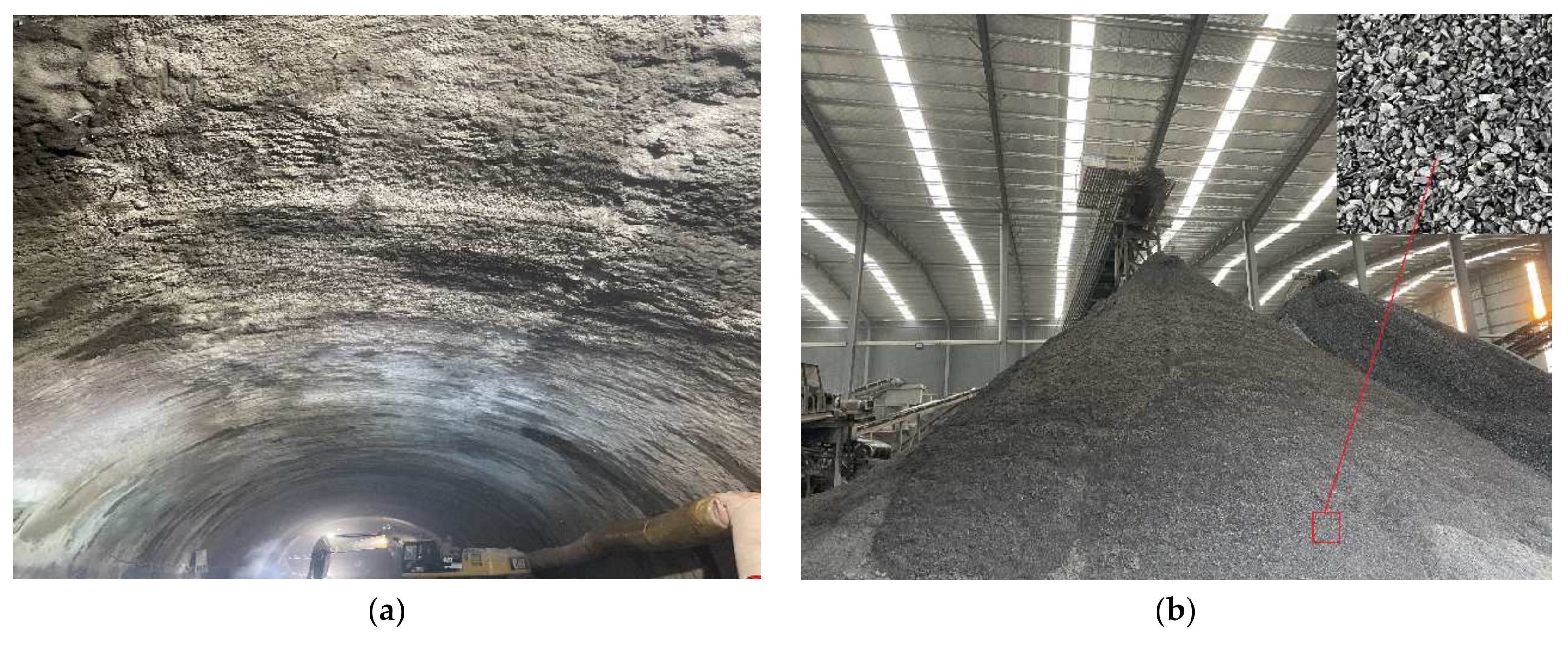

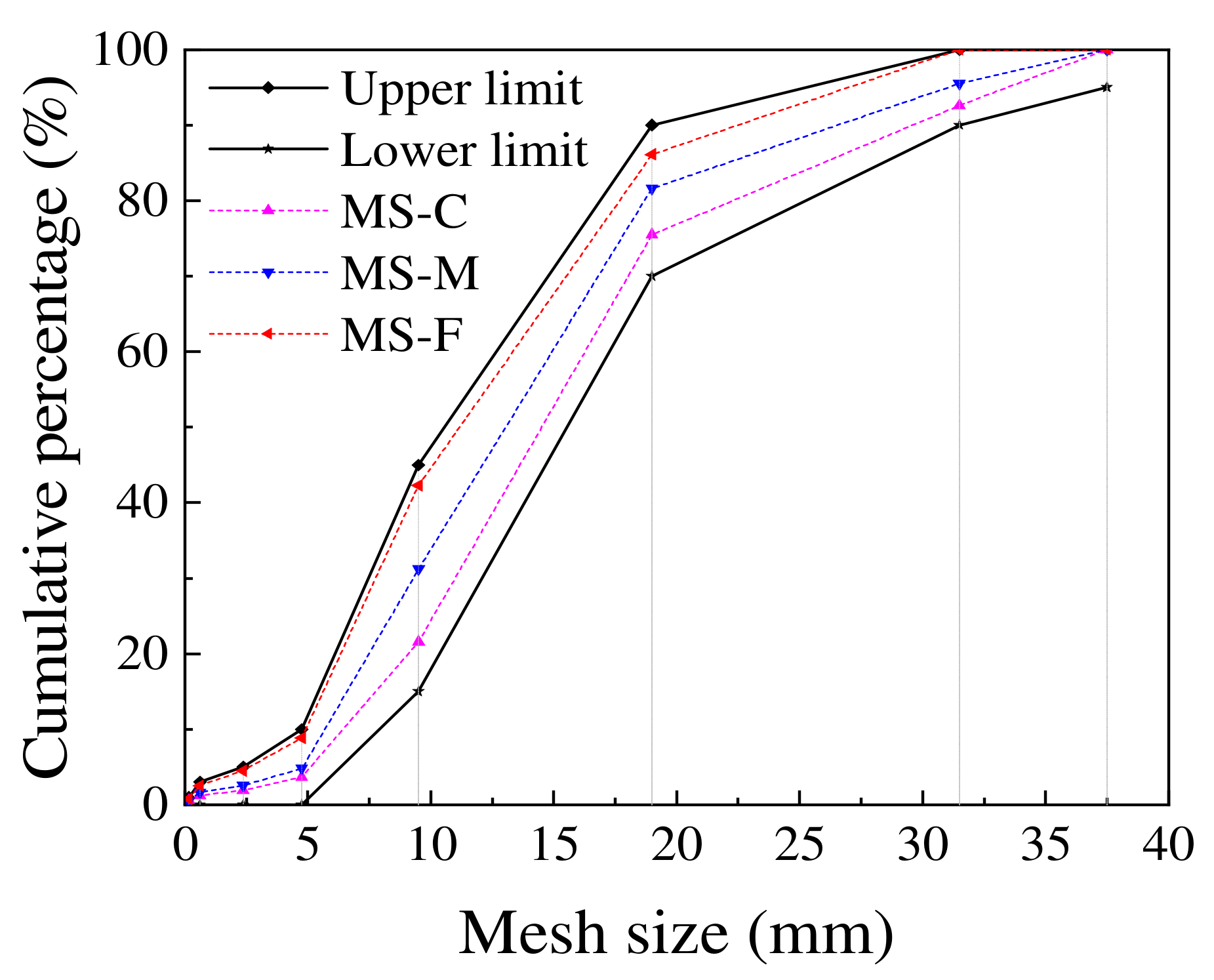
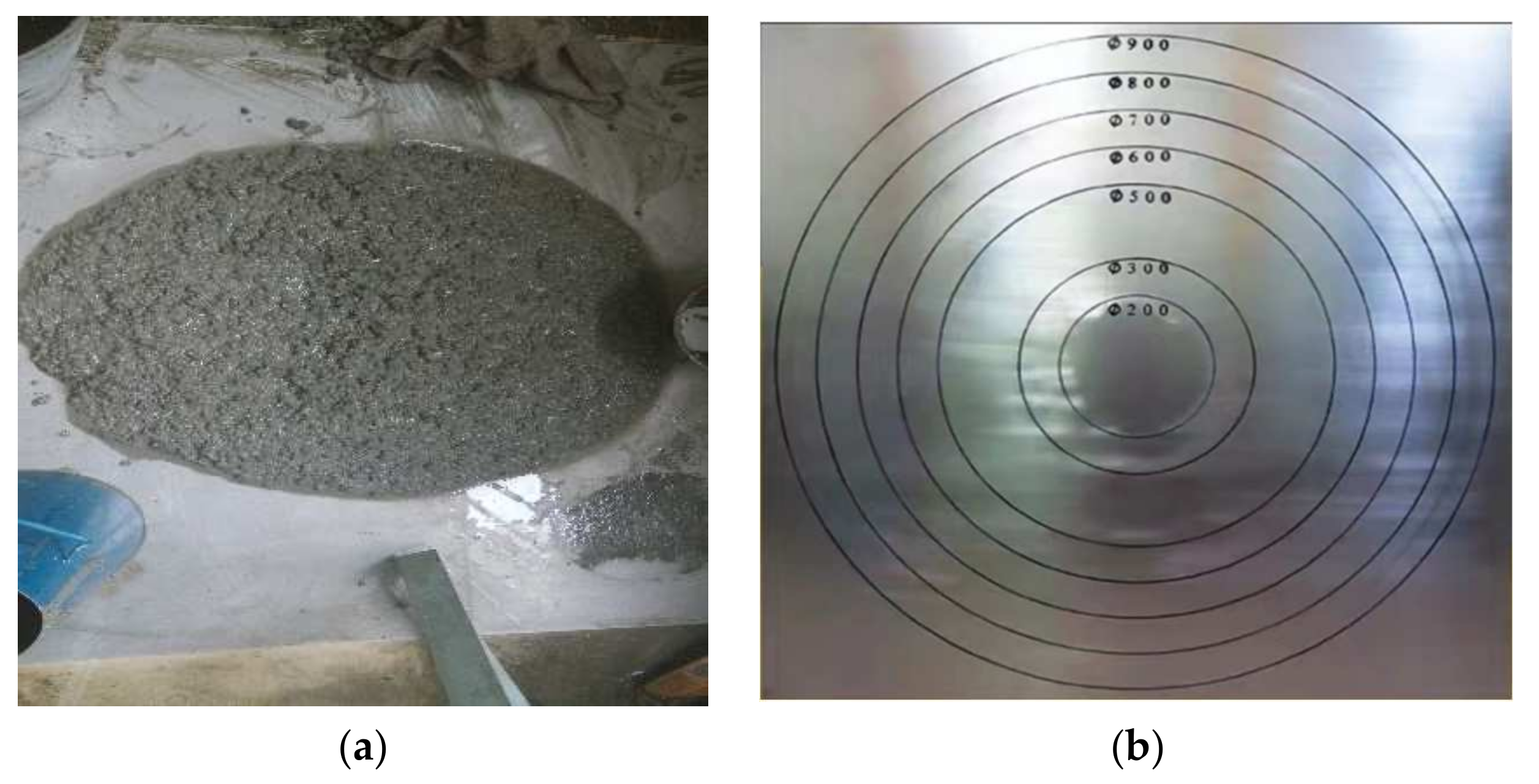

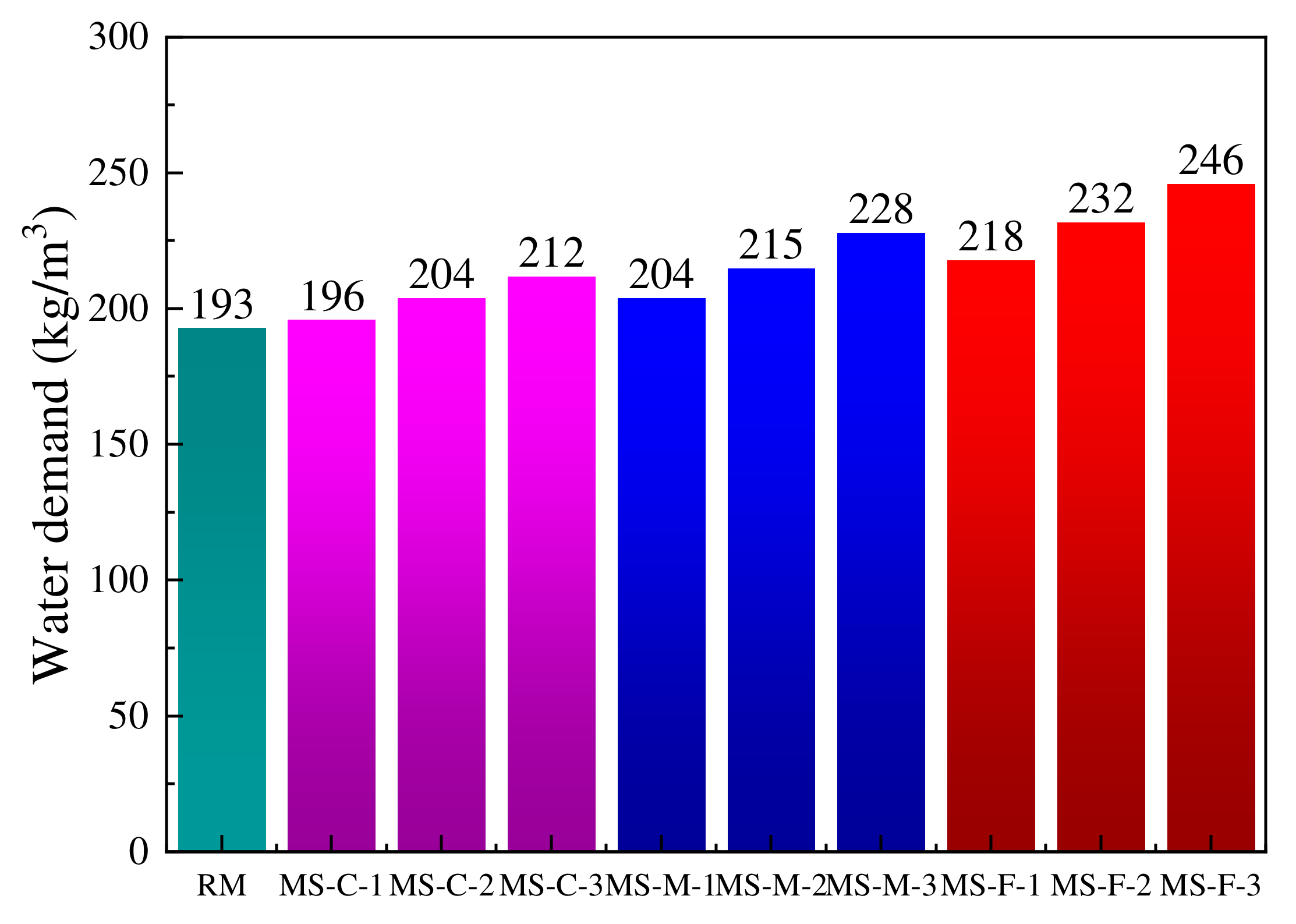
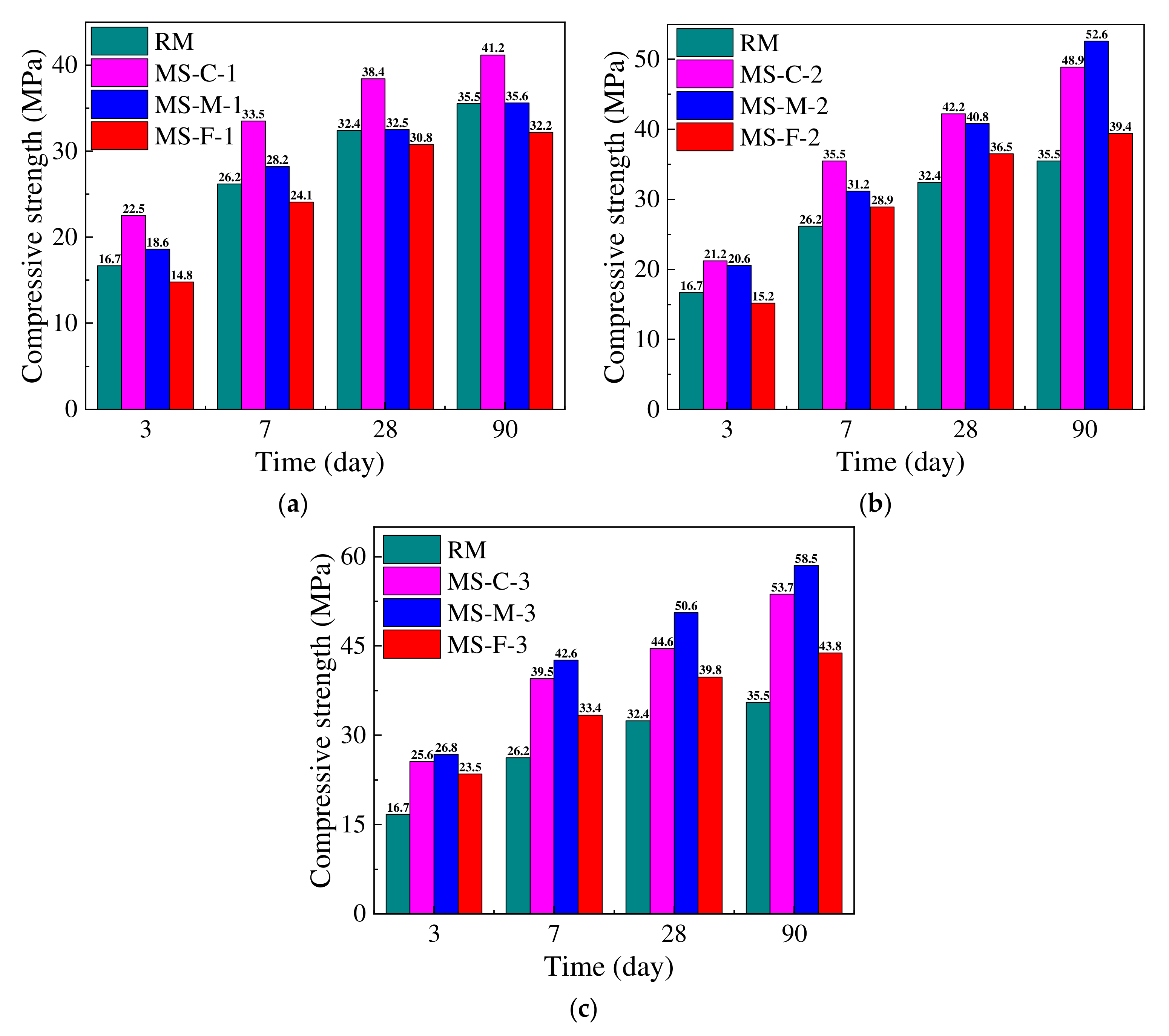
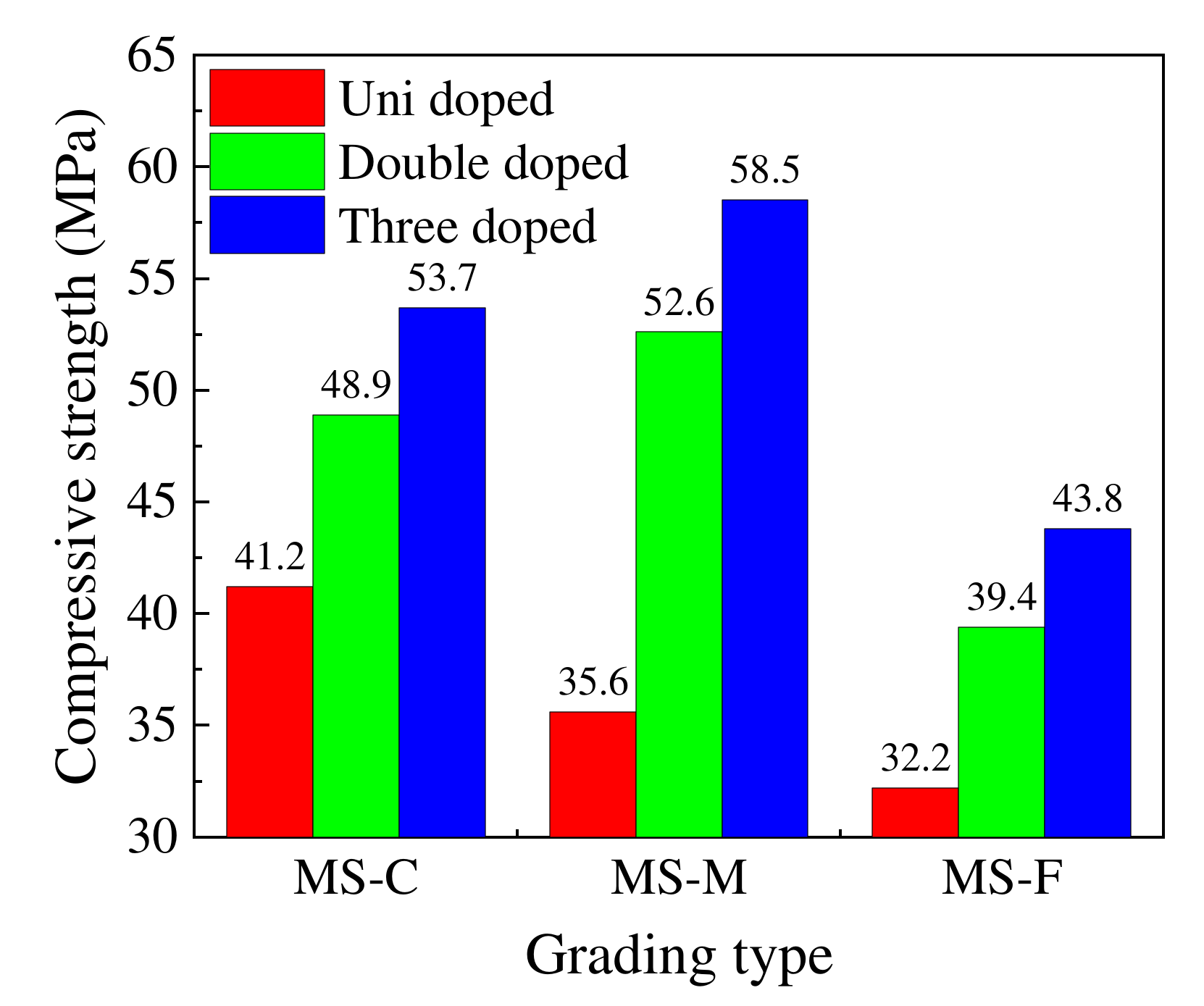
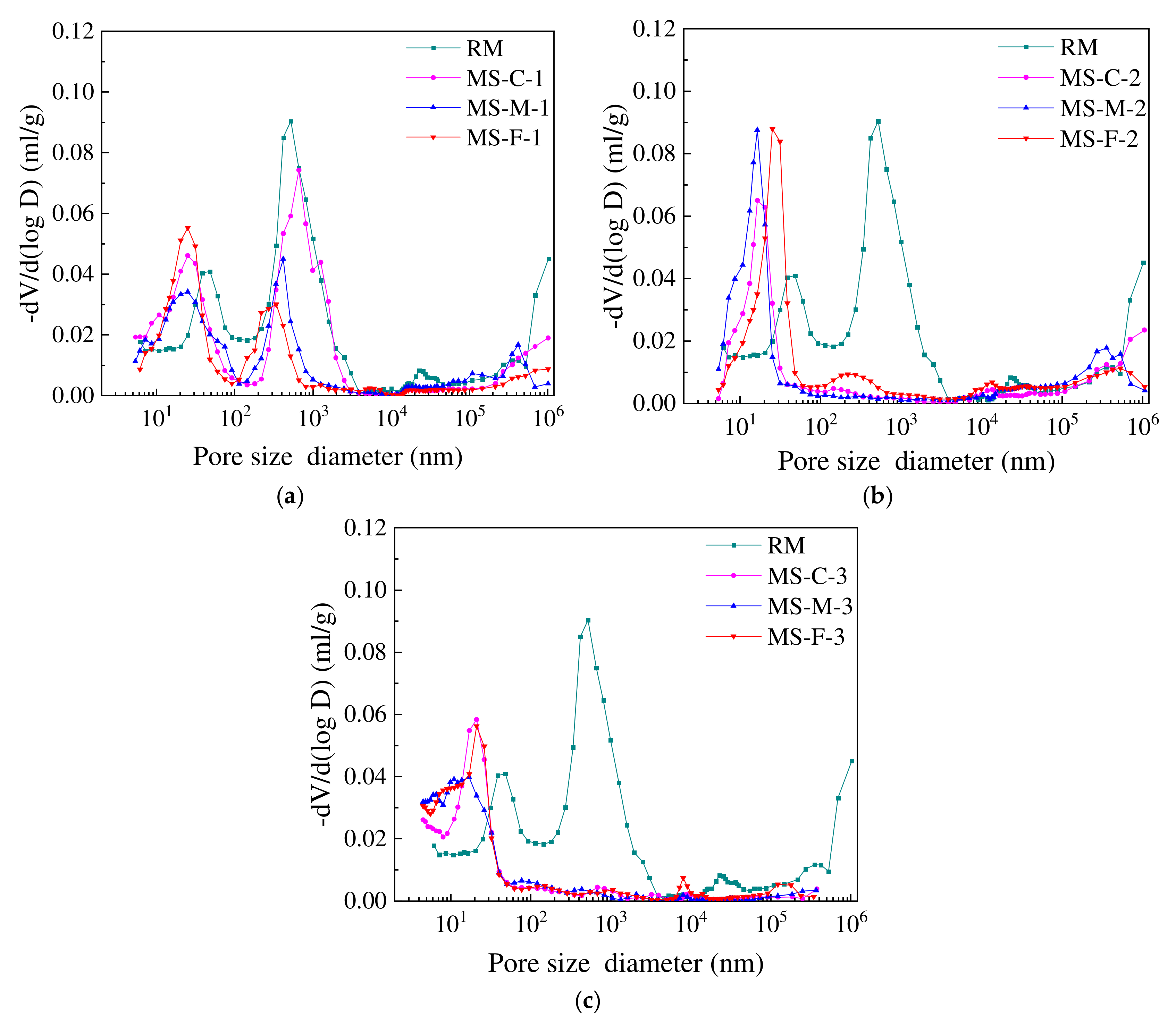

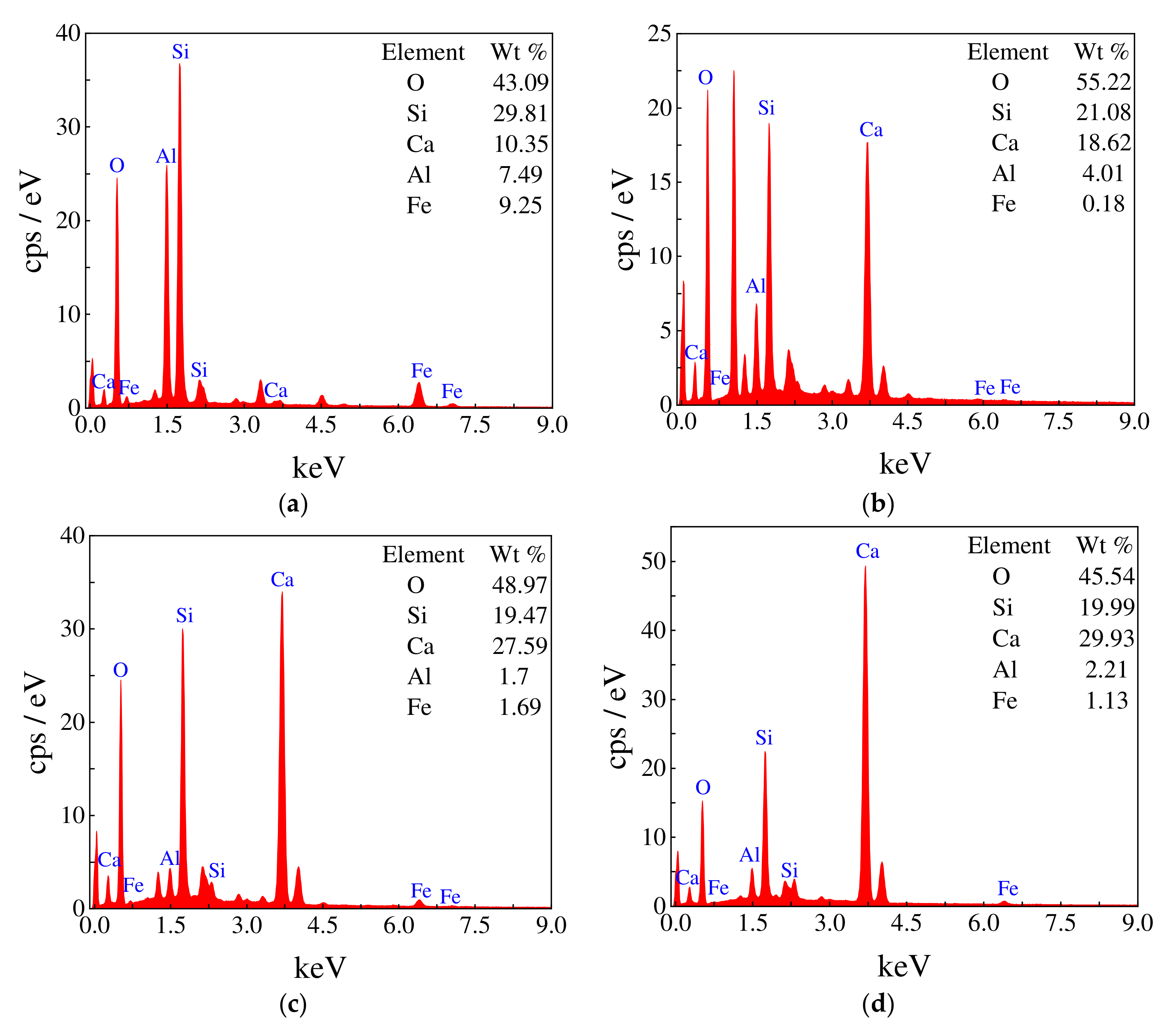
| Chemical Composition (%) | PC | FA | SF | RM |
|---|---|---|---|---|
| SiO3 | 19.8 | 36.9 | 93.6 | 66.3 |
| Fe2O3 | 4.2 | 6.3 | 1.7 | 6.2 |
| MgO | 4.7 | 8.6 | 1.2 | 0.7 |
| Al2O3 | 5.3 | 11.2 | 0.2 | 3.6 |
| CaO | 61.7 | 32.9 | 1.5 | 21.6 |
| SO3 | 2.1 | 1.8 | 1.1 | 1.2 |
| LOI | 2.2 | 2.3 | 0.7 | 0.4 |
| Specific surface area (m2/kg) | 396 | 263 | 2150 | 1390 |
| Specific gravity (kg/m3) | 3.12 | 2.66 | 1.87 | 1.86 |
| Mix No. | Water | Cement | FA | SF | RM | Fine MS Aggregate | Coarse MS Aggregate | Super Plasticizer |
|---|---|---|---|---|---|---|---|---|
| RC | 193 | 485 | 0 | 0 | 0 | 676 | 862 | 1.46 |
| MS-C-1 | 196 | 410 | 75 | 0 | 0 | 555 | 983 | 1.52 |
| MS-C-2 | 204 | 410 | 60 | 15 | 0 | 555 | 983 | 1.52 |
| MS-C-3 | 212 | 410 | 50 | 10 | 15 | 555 | 983 | 1.49 |
| MS-M-1 | 204 | 410 | 75 | 0 | 0 | 676 | 862 | 1.48 |
| MS-M-2 | 215 | 410 | 60 | 15 | 0 | 676 | 862 | 1.49 |
| MS-M-3 | 228 | 410 | 50 | 10 | 15 | 676 | 862 | 1.51 |
| MS-F-1 | 218 | 410 | 75 | 0 | 0 | 758 | 780 | 1.48 |
| MS-F-2 | 232 | 410 | 60 | 15 | 0 | 758 | 780 | 1.49 |
| MS-F-3 | 246 | 410 | 50 | 10 | 15 | 758 | 780 | 1.49 |
| Mix No. | Pore Size Distribution (%) | Average Pore Size (4 V/A) (nm) | Porosity (%) | |||
|---|---|---|---|---|---|---|
| d ≤ 20 nm | 20 nm ≤ d ≤ 50 nm | 50 nm ≤ d ≤ 200 nm | d > 200 nm | |||
| RC | 8.3 | 13.6 | 10.4 | 67.6 | 69.4 | 20.5 |
| MS-C-1 | 29.2 | 31.5 | 6.2 | 33.0 | 25.7 | 12.4 |
| MS-M-1 | 21.8 | 22.2 | 14.1 | 41.8 | 34.5 | 12.5 |
| MS-F-1 | 29.1 | 35.4 | 4.4 | 31.1 | 26.9 | 11.4 |
| MS-C-2 | 19.9 | 12.4 | 21.4 | 46.3 | 25.1 | 10.0 |
| MS-M-2 | 14.4 | 21.1 | 27.6 | 36.8 | 23.2 | 12.7 |
| MS-F-2 | 35.6 | 32.1 | 3.5 | 29.2 | 37.7 | 13.8 |
| MS-C-3 | 50.5 | 6.9 | 4.6 | 37.8 | 21.5 | 11.8 |
| MS-M-3 | 50.1 | 3.6 | 2.2 | 44.2 | 24.3 | 10.6 |
| MS-F-3 | 27.1 | 24.7 | 5.4 | 42.7 | 42.2 | 13.9 |
| Total Number Spectrum of Distribution | Element Content (%) | |||
|---|---|---|---|---|
| Element | (a) | (b) | (c) | (d) |
| O | 43.09 | 55.22 | 48.97 | 45.54 |
| Si | 29.81 | 21.08 | 19.47 | 19.99 |
| Ca | 10.35 | 18.62 | 27.59 | 29.93 |
| Al | 7.49 | 4.01 | 1.7 | 2.21 |
| Fe | 9.25 | 0.18 | 1.69 | 1.13 |
| Total: | 99.99 | 100.00 | 99.42 | 98.8 |
Publisher’s Note: MDPI stays neutral with regard to jurisdictional claims in published maps and institutional affiliations. |
© 2022 by the authors. Licensee MDPI, Basel, Switzerland. This article is an open access article distributed under the terms and conditions of the Creative Commons Attribution (CC BY) license (https://creativecommons.org/licenses/by/4.0/).
Share and Cite
Hu, Y.; Wei, Y.; Zhao, L.; Zhang, W.; Chen, S. Study on the Strength and Microcosmic Characteristics of C50 High-Performance Concrete (HPC) Containing Manufactured Sands. Buildings 2022, 12, 1657. https://doi.org/10.3390/buildings12101657
Hu Y, Wei Y, Zhao L, Zhang W, Chen S. Study on the Strength and Microcosmic Characteristics of C50 High-Performance Concrete (HPC) Containing Manufactured Sands. Buildings. 2022; 12(10):1657. https://doi.org/10.3390/buildings12101657
Chicago/Turabian StyleHu, Yafeng, Yang Wei, Longlong Zhao, Wenhua Zhang, and Si Chen. 2022. "Study on the Strength and Microcosmic Characteristics of C50 High-Performance Concrete (HPC) Containing Manufactured Sands" Buildings 12, no. 10: 1657. https://doi.org/10.3390/buildings12101657







